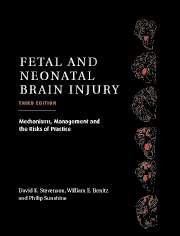Book contents
- Frontmatter
- Contents
- List of contributors
- Foreword
- Preface
- Part I Epidemiology, Pathophysiology, and Pathogenesis of Fetal and Neonatal Brain Injury
- Part II Pregnancy, Labor, and Delivery Complications Causing Brain Injury
- Part III Diagnosis of the Infant with Asphyxia
- 20 Clinical manifestations of hypoxic–ischemic encephalopathy
- 21 The use of the EEG in assessing acute and chronic brain damage in the newborn
- 22 Structural and functional imaging of hypoxic–ischemic injury (HII) in the fetal and neonatal brain
- 23 Near-infrared spectroscopy and imaging
- 24 Placental pathology and the etiology of fetal and neonatal brain injury
- 25 Correlations of clinical, laboratory, imaging and placental findings as to the timing of asphyxial events
- Part IV Specific Conditions Associated with Fetal and Neonatal Brain Injury
- Part V Management of the Depressed or Neurologically Dysfunctional Neonate
- Part VI Assessing the Outcome of the Asphyxiated Infant
- Index
- Plate section
25 - Correlations of clinical, laboratory, imaging and placental findings as to the timing of asphyxial events
from Part III - Diagnosis of the Infant with Asphyxia
Published online by Cambridge University Press: 10 November 2010
- Frontmatter
- Contents
- List of contributors
- Foreword
- Preface
- Part I Epidemiology, Pathophysiology, and Pathogenesis of Fetal and Neonatal Brain Injury
- Part II Pregnancy, Labor, and Delivery Complications Causing Brain Injury
- Part III Diagnosis of the Infant with Asphyxia
- 20 Clinical manifestations of hypoxic–ischemic encephalopathy
- 21 The use of the EEG in assessing acute and chronic brain damage in the newborn
- 22 Structural and functional imaging of hypoxic–ischemic injury (HII) in the fetal and neonatal brain
- 23 Near-infrared spectroscopy and imaging
- 24 Placental pathology and the etiology of fetal and neonatal brain injury
- 25 Correlations of clinical, laboratory, imaging and placental findings as to the timing of asphyxial events
- Part IV Specific Conditions Associated with Fetal and Neonatal Brain Injury
- Part V Management of the Depressed or Neurologically Dysfunctional Neonate
- Part VI Assessing the Outcome of the Asphyxiated Infant
- Index
- Plate section
Summary
Following the birth of a depressed newborn, the infant's caretakers are involved in providing appropriate resuscitative techniques, stabilizing the infant's biochemical and physiological abnormalities, and evaluating the infant's response to these measures. The caretakers must also ascertain the cause of the infant's depression, attempt to determine when the event or events leading to the depression occurred, and develop a plan for follow-up evaluation and treatment that will be required. The determination of causation and timing not only has medical–legal implications, but is becoming extremely important in order to evaluate the types of therapy that may be utilized to mitigate the effects of a hypoxic–ischemic event. If the infant had suffered significant damage days or weeks prior to birth, then these rescue forms of therapy will have little, if any, beneficial effect on the infant's eventual outcome. In many situations, this determination is very difficult to make as there may be a myriad of events that could have occurred prior to the time of birth, and overlapping of significant problems makes this exercise an almost impossible task at times.
When an acute or sentinel event has taken place, such as a readily recognized prolapsed cord, an abruptio placentae, a ruptured uterus, or a disorder leading to acute and profound blood loss in the fetus, the timing of the event can be ascertained with a reasonable degree of accuracy.
- Type
- Chapter
- Information
- Fetal and Neonatal Brain InjuryMechanisms, Management and the Risks of Practice, pp. 540 - 550Publisher: Cambridge University PressPrint publication year: 2003



